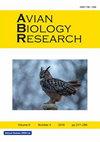Possible Functions of Tail-Pumping by American Kestrels (Falco Sparverius)
IF 1.2
4区 农林科学
Q4 AGRICULTURE, DAIRY & ANIMAL SCIENCE
引用次数: 2
Abstract
When perched, several species of small falcons, including American Kestrels (Falco sparverius), often pump their tails, but the possible function of this behaviour is unknown. Our objective was to use observations and experiments to examine the possible function(s) of tail-pumping by American Kestrels. Fieldwork was conducted from March 2015 to December 2015 at the Blue Grass Army Depot in Madison County, Kentucky. During observations of focal kestrels, we noted their behaviour (e.g. landing on a perch, hunting, or consuming prey), including when and how often they pumped their tails (i.e. rapid movement of the tail down, then back up to its original position). Kestrels typically tail-pumped when landing on a perch (mean = 4.1±0.2 pumps per 10 s) and consuming prey (mean = 2.4±0.2 pumps per 10 s). When hunting, kestrels tail-pumped at higher rates during the 30 s prior to attacking (mean = 1.1±0.3 pumps) than they did during the 30–60 s interval before an attack (mean = 0.3±0.1 pumps). During experiments where kestrels were presented with models of a conspecific and a predator (Cooper's Hawk, Accipiter cooperi), we found no difference in rates of tail-pumping prior to and during the presentation. These results suggest that tail-pumping by American Kestrels is not used either to communicate with conspecifics or as a predator-deterrent signal. Rather, kestrels appear to tail-pump to help maintain balance on perches when landing and consuming prey. In addition, prior to attacking prey, kestrels typically bob their heads (possibly to aid in judging distances), and tail-pumping may help them maintain stability as they head-bob and prepare to attack.美国红隼(Falco Sparverius)的抽尾功能
当栖息时,包括美国红隼(Falco sparverius)在内的几种小型猎鹰经常拍打尾巴,但这种行为的可能功能尚不清楚。我们的目的是利用观测和实验来检验美国红隼尾巴抽气的可能功能。实地调查于2015年3月至2015年12月在肯塔基州麦迪逊县的蓝草陆军仓库进行。在观察局灶性红隼的过程中,我们注意到了它们的行为(例如,降落在栖木上、狩猎或捕食猎物),包括它们抽尾巴的时间和频率(即尾巴向下快速移动,然后回到原来的位置)。红隼在栖息处着陆时(平均每10秒4.1±0.2次)和捕食猎物时(平均值每10秒2.4±0.2次,)通常会抽尾。在狩猎时,红隼在攻击前的30秒内(平均值=1.1±0.3泵)以比攻击前的30-60秒间隔(平均值=0.3±0.1泵)更高的速率抽尾。在向红隼展示同种和捕食者模型(Cooper's Hawk,Accipiter cooperi)的实验中,我们发现展示前和展示期间的抽尾率没有差异。这些结果表明,美国红隼的抽尾既不是用来与同种动物交流,也不是用来作为捕食者的威慑信号。相反,红隼在降落和捕食猎物时,似乎会用尾泵来帮助维持栖息处的平衡。此外,在攻击猎物之前,红隼通常会摇头(可能是为了帮助判断距离),抽尾可能有助于它们在摇头和准备攻击时保持稳定。
本文章由计算机程序翻译,如有差异,请以英文原文为准。
求助全文
约1分钟内获得全文
求助全文
来源期刊

Avian Biology Research
农林科学-奶制品与动物科学
CiteScore
1.50
自引率
0.00%
发文量
17
审稿时长
2 months
期刊介绍:
Avian Biology Research provides a forum for the publication of research in every field of ornithology. It covers all aspects of pure and applied ornithology for wild or captive species as well as research that does not readily fit within the publication objectives of other ornithological journals. By considering a wide range of research fields for publication, Avian Biology Research provides a forum for people working in every field of ornithology.
 求助内容:
求助内容: 应助结果提醒方式:
应助结果提醒方式:


